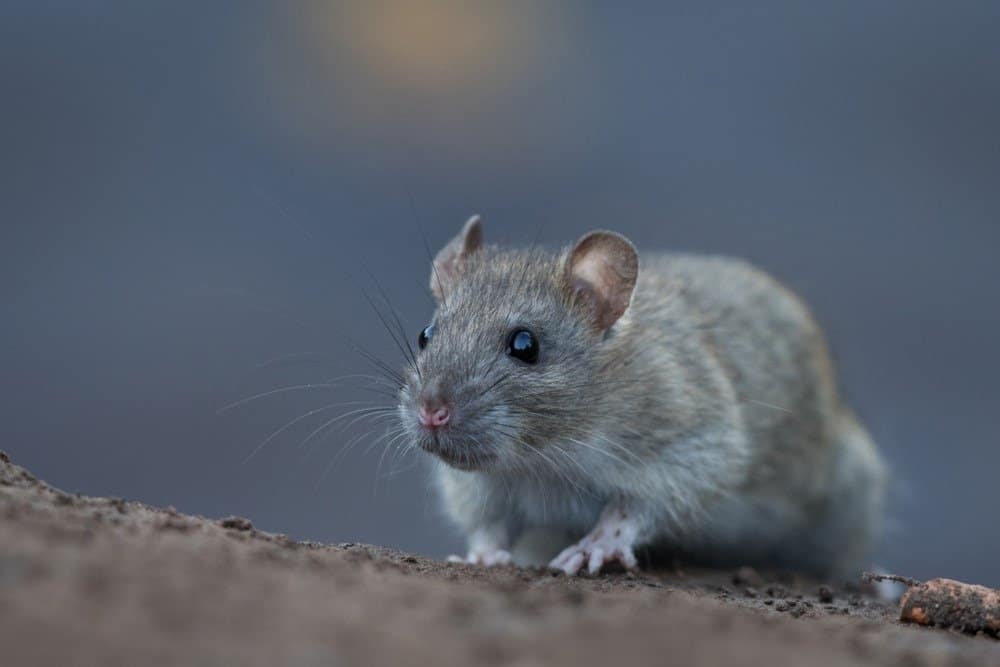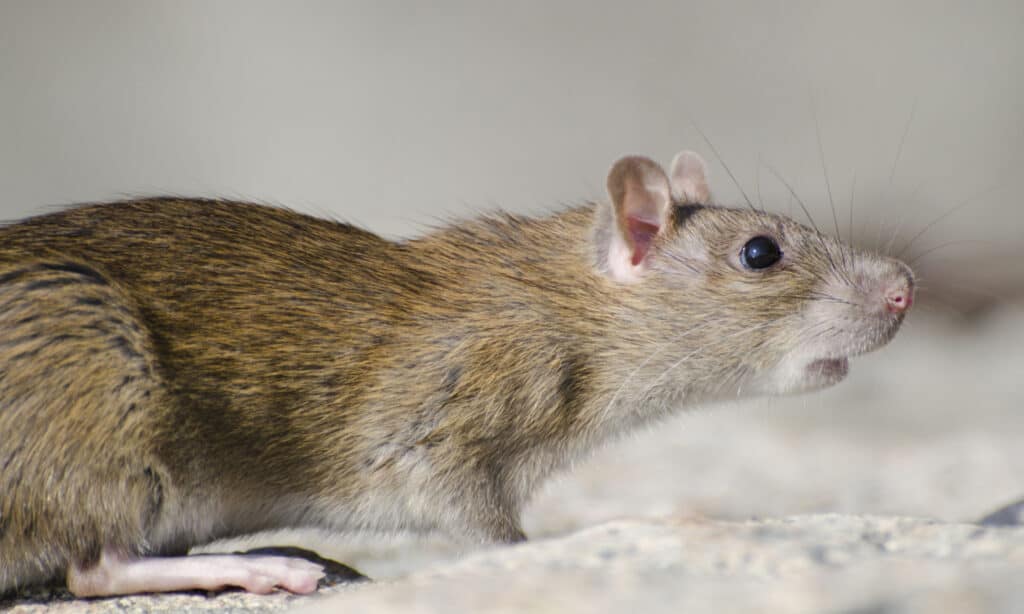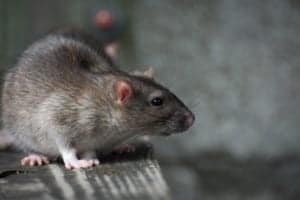Some of the most common rat species live across the U.S. Rats are medium-sized rodents that have long tails. These mammals look similar to other rodents, like mice and possums, but differ significantly. Rats live all over America, with Chicago being the city with the most rats. Also, there are four dominant and common rat species in America, and these live mainly in urban and suburban areas. Because cities are excellent sources of food, shelter, and warmth, rats naturally prefer living in these areas. This article explores several types of rats, specifically the four most common rat species in the United States.
The Most Common U.S. Rats Include the Norway Rat

The Norway rat is one of the most common U.S. rat species.
©JaklZdenek/Shutterstock.com
The Norway rat is one of four main common rats living in the U.S. Also known as brown or water rat, its coat ranges from brown to dark gray. Norway rats grow roughly 8 to 10 inches, while their tails range from 7 to 10 inches long. Male Norway rats can reach 12 ounces in weight, while female Norway rats typically achieve a maximum weight of approximately 9 ounces.
Norway rats are nocturnal mammals but may be active during the day if the population is high. These rats have poor eyesight and are color blind, which makes them rely on their other senses to move around and find food. Additionally, Norway rats are known to burrow and build nests on or beneath the ground. These rodents prefer to use materials like shredded paper, cloth, or other fibrous material in their nests. They produce a litter of 6-12 baby rats at a time, averaging between four and six litters yearly.
Norway rats also carry bacteria and pathogens that can cause diseases. Diseases carried by Norway rats include:
- Weil’s disease
- Rat bite fever
- Cryptosporidiosis
- Viral hemorrhagic fever
- Q fever
- Hantavirus pulmonary syndrome
- Toxoplasmosis
The Roof Rat – Another Common Rat Species

One of the most common rat species in America includes roof rats, which eat a wide range of foods and are omnivorous mammals.
©Carlos Aranguiz/Shutterstock.com
The roof rat is also known as the house, black, or the ship rat and has a black to light brown coat. Adult roof rats grow 13 to 15 inches and have a 6 to 9 inches long tail. In addition, adult roof rats weigh between 0.3 and 0.6 pounds.
Roof rats are native to India and other Indo-Malayan countries but were introduced to the U.S. when boats and ships docked along the country’s shores. The name “ship rat” originates from this past. Typically, you also find roof rats in urban and suburban areas and other locations close to water sources and with a warmer climate.
Roof rats eat a wide range of foods and are omnivorous mammals. These rats also present an issue for farmers and homeowners, as they often eat the food meant for cows, swine, chickens, cats, and dogs. This consumption is a problem, as the rats can contaminate these food sources and infect livestock and people.
Roof rats are said to be the cause and carrier of the Black Death that wiped out two-thirds of the European population during the 14th century.
In addition, roof rats often carry diseases like:
- Bubonic plague
- Typhus
- Weil’s disease
- Toxoplasmosis
- Trichinosis
The Woodrat

Woodrats are another common rat species in the U.S. that use the excrement of other animals to build their nests, promoting the spread of disease.
©iStock.com/Moment of Perception Photography
The woodrat, also known as the packrat, is cinnamon, brown, or gray. Adult woodrats grow between 10 and 18.5 inches and weigh in at 9.5 to 14 ounces, with males often being more prominent and heavier than their female counterparts.
Woodrats look different from other rats as they have large, round ears, big, dark eyes, and bushy tails, which mimic that of a squirrel. Pack rats are native to North America and often build their nests in deserts under cacti, caves, and trees. But these rats also favor building their nests in homes. Woodrats are known to be nest builders and notoriously collect shiny objects and artificial materials to beautify their nests. If you find a woodrat nest, it will typically be notable for having different compartments, ideal for living, food, and waste.
Woodrats also use the excrement of other animals to build their nests, promoting the spread of disease. Pack rats or woodrats have a reputation for carrying and transmitting diseases like:
- Arenavirus
- Hantavirus
- Trichinosis
- Bubonic plague
- Typhoid
- Weil’s disease
- Salmonella
The woodrat is a diverse species, with the populations being in the hundreds of thousands. Unfortunately, some species of woodrats are in decline and even endangered. For example, the Allegheny woodrat is in danger of dying out, although its population is 100,000 strong. There are also subspecies of the eastern woodrat that are in danger or under threat of disappearing in areas and states like Key Largo, Florida, North Carolina, and Tennessee.
The Marsh Rice Rat – A Common Rat Species

Large populations of marsh rice rats live in
Florida
, Virginia, Maryland, North Carolina, Georgia, Tennessee, Mississippi, Louisiana, and Texas.
©Oakland Images/Shutterstock.com
Marsh rice rats are brown to gray, with off-white underbellies. Their tails are usually dark brown, but the underside may be paler than the topside. Marsh rice rats are excellent swimmers because they trap air in their fur when they swim, giving them extra buoyancy. Marsh rice rats grow between 9 and 12 inches and have approximately 4-6 inches long tails. Adult marsh rice rats can reach weights of between 1.4 to 2.8 ounces, with males usually larger than females.
Marsh rice rats have large populations in Florida, Virginia, Maryland, North Carolina, Georgia, Tennessee, Mississippi, Louisiana, and Texas. Marsh rice rats in Florida are often redder, while western marsh rice rats are lighter in color. You will frequently find these rats living near water sources as they have adapted to these environments.
Their front feet feature four digits, with no tufts of hair. In contrast, their hind feet are broad and feature five digits connected with interdigital webs and little to no hair tufts to assist in faster swimming.
Marsh rice rats also carry a range of diseases. They are the second most common cause of Hantavirus infections in the U.S. and are the primary host of the Bayou virus.
Common rat species like the Marsh Rice rats also carry diseases like:
- Arenavirus
- Lyme disease
- Bartonella
Summary of the Most Common Rat Species
| Rank | Species | Length | Weight |
|---|---|---|---|
| 1 | Norway Rat | Roughly 8 to 10 inches (their tails are 7 to 10 inches long) | Approximately 9 ounces (maximum). |
| 2 | Roof Rat | Between 13 and15 inches (their tails are 6 to 9 inches long) | Between 0.3 and 0.6 pounds. |
| 3 | Woodrat | Between 10 and 18.5 inches | Between 9.5 and 14 ounces |
| 4 | Marsh Rice Rat | About 9 to 12 inches (their tails are 4 to 6 inches long) | Between 1.4 to 2.8 ounces |
The photo featured at the top of this post is © Gallinago_media/Shutterstock.com
Thank you for reading! Have some feedback for us? Contact the AZ Animals editorial team.






